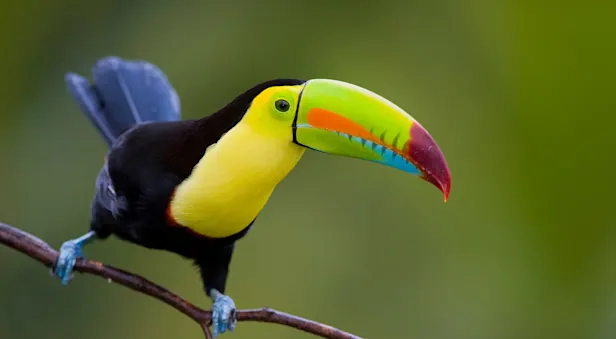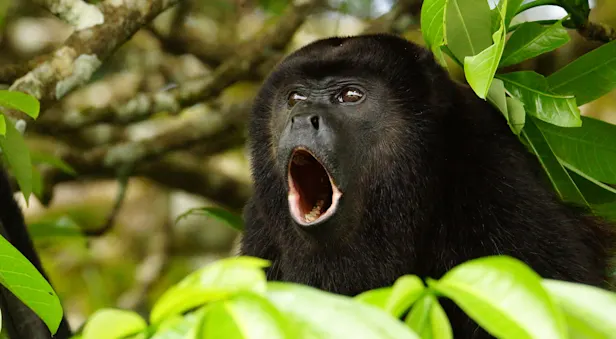Know Before You Go
Insect Facts | Costa Rica Wildlife Guide
Deep in the cover of the old-growth rainforests, an astounding abundance of unique, exotically colored and often bizarre-looking tropical insects have evolved. Thousands of varieties of butterflies, beetles, moths, dragonflies, bees, grasshoppers, termites and ants inhabit the jungle, with possibly thousands of insect species yet to be identified.
Large, brilliantly painted butterflies such as the magnificent, sapphire-blue morpho fly alongside microscopic insects such as the hummingbird flower mite. Mites measure only half a millimeter in length, and they ride from flower to flower inside the nostrils of hummingbirds. If you listen, you may hear the loud, grating sounds made by male wood crickets when they rub their wing cases together.
Many exotic-looking species are immediately recognizable—the scuttling rhinoceros beetle possesses a long, curved horn that reaches skyward on its head, and spiders bear dazzling markings. Some spiders prey upon insects by disguising themselves as colorful flower buds on leafstalks. There is also a host of biting insects to be wary of, including midges, ticks, mosquitos, wasps and chiggers.
Leaf-Cutter Ant

There is something charming about the leaf-cutter ant—a fungus-farming insect inhabiting the lowland forest. In its jaw it carries a crescent green leaf cut from a plant. Long lines of leaf-cutters toil along with their leafy green shards, clearing an immaculately swept path along the forest floor. Their underground chambers are as deep as 20 feet and can cover more than 650 square feet in area. Nests can contain as many as 5 million ants.
Ant societies consist purely of females; males live only to fertilize the queen, and then they perish. Only the queen, who can be a thousand times the weight of a minor worker ant, is fertile, and thus every other ant in the colony is her daughter.
Each ant has its own task based on its size. Most ants are smaller, minor workers who tend to the nest. Major workers are larger, about three-quarters of an inch in length, and act as guards to the leaf-cutting, median-sized workers. The workers’ duties consist of setting out day and night to strip trees of every leaf, shoot and stem. They form a long path, and, section by section, they bring the material to their underground nest. Leaf-cutter ants do not ingest this plant matter; instead, they chew it to create a kind of compost. From this compost, a nutrient-rich white fungus grows, and the ants feed on the small fruiting bodies of the fungus.
Army Ant

The most formidable members of the ant species are army ants that march in groups of thousands or millions through the jungle. Their sole purpose is to overtake and devour small creatures within a matter of minutes, turning them into skeletons. The ants make a low hissing noise and possess a unique odor.
The jaws of an army ant are so strong that certain indigenous tribes once relied on them to stitch open wounds. An ant was held over a wound and its body was squeezed so that its jaw clamped shut, cinching the flesh together. Then, the ant’s body was pinched off, and the wound was left to heal.
Images of people and animals fleeing from massive armies of ants are mostly the result of Hollywood sensationalism. Large animals are easily able to step aside and let the ant armies pass by. Army ants will push small prey across the forest floor, a process that can take several hours. Even when these ants raid human homes, people are able to step aside and wait while the ants act as exterminators, clearing out cockroaches, fleas, and other small vermin.
An ant army carries larvae, which secretes chemical messages that stimulate the workers to keep moving. When the larvae become pupae, no longer producing pheromones, the army ants cling together to create a large ball out of their collective bodies, forming a nest called a bivouac. There are chambers and passages inside the bivouac that contain food as well as the queen, who prepares to lay more eggs. After her eggs are laid and the larvae hatch, the cycle continues once again. The pupae become more soldiers and workers, and the larvae exude the pheromone that inspires the army to set off into the bush once again.
Photo Credit: Bernard Dupont (Army Ants) [CC BY-SA 2.0], via Wikimedia Commons


























